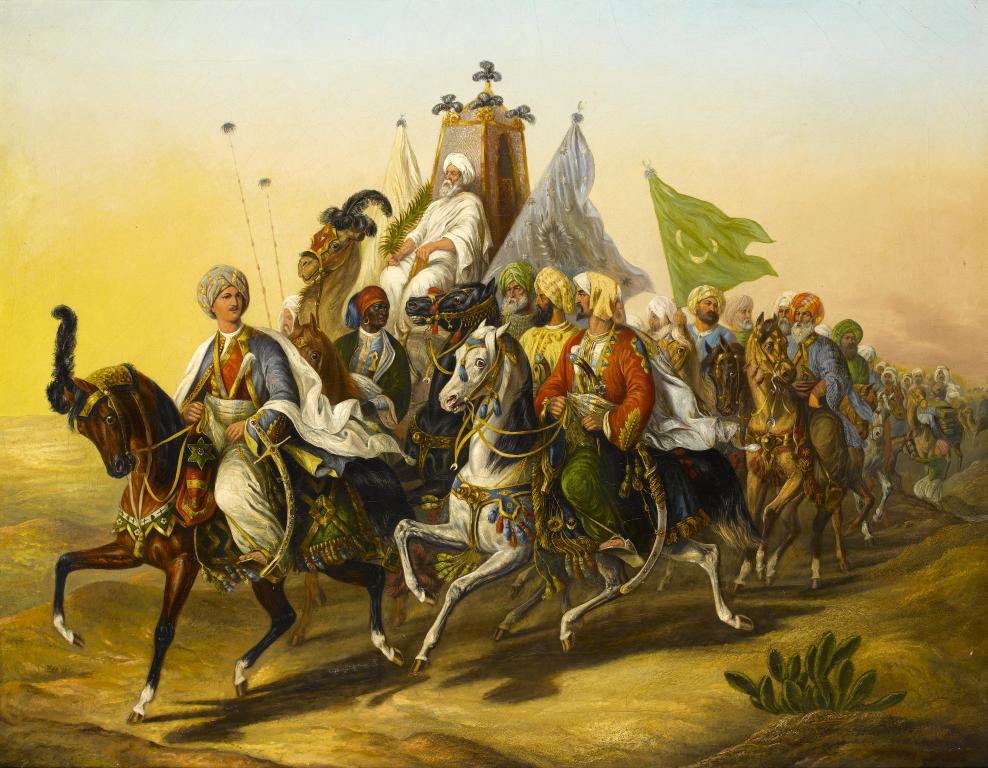George DENHOLM ARMOUR (1864-1949)
The Retinue of the Mahmal in Procession
oil on canvas
Inscribed 'GDA' on the stretcher
27 1/2 x 35 3/8 inches
(70 x 90 cms)
Price: Sold
This remarkable and rare painting depicts the procession in 1892 of the Mahmal, or ceremonial palanquin, as part of the Hajj, the sacred journey to Mecca. This is unquestionably a rare subject in art, and European painters have seldom been permitted to take part in the main stages of the Hajj.
The subject matter of the painting is all the more remarkable as the travelers themselves are shown as members of a powerful dynasty of rulers - the descendants of Muhammad Ali of Egypt - and include portraits of the succession of rulers of Egypt and their followers. The painting has a particular level of detail that allows us not only to recognize the members of this dynasty but also to interpret a plethora of details including pennants, inscriptions, badges, and elements of dress, placed by the artist to contribute to the narrative of the journey and the distinctions of this ruling family.
Of further note is the fact that the dynasty of Muhammad Ali was especially renowned for its knowledge and expertise in the breeding of Arab horses, and various members of the family made significant contributions to modern equine history in Arabia.
The artist of this work, George Denholm Armour, is regarded as one of finest horse painters of the first half of the twentieth century. Born in Scotland and initially based in London, he spent much of the 1890s to 1920s traveling and working, with trips to America, Europe, and North Africa, often in the company of other renowned sporting artists. A small number of powerful Orientalist paintings by Armour emanate from this period, of which the present work is the undoubted masterpiece.
The present painting is of exceptional interest, not only as a highly unusual Western depiction of the Hajj, painted by a British artist of exceptional quality and stature, but it is also as an extraordinarily rare dynastic portrait of a historic and powerful ruling family - one with a famous equine history - and that family's historic sovereignty over Egypt.
Muhammad Ali
The dynasty of Muhammad Ali was the ruling dynasty of Egypt and Sudan from the early nineteenth to the mid-twentieth century. Named after its progenitor, Muhammad Ali Pasha - regarded as the founder of modern Egypt - it was also more formally known as the Alawiyya Dynasty, or more commonly the Khedival Dynasty, as a majority of the rulers bore the title Khedive.
Muhammad Ali (right), commander of the Ottoman army, was sent to drive Napoleon's forces out of Egypt, but upon the French withdrawal, took power himself and negotiated with the Ottoman Sultan Mahmud II to recognize him as Wāli, or Governor of Egypt in 1805. He himself then took the title of Khedive.
Muhammad Ali transformed Egypt into an international power which he saw as the natural successor to the decaying Ottoman Empire. He summed up his vision for Egypt in this way: "I am well aware that the (Ottoman) Empire is heading by the day toward destruction ... On her ruins, I will build a vast kingdom ... up to the Euphrates and the Tigris."
At the height of his power, Muhammad Ali's military strength, and that of his son Ibrahim Pasha did indeed threaten the very existence of the Ottoman Empire as he sought to supplant the Osman Dynasty with his own. Ultimately, the intervention of world powers prevented Egyptian forces from marching on Constantinople, and henceforth the dynasty's rule would be limited to Africa and Sinai.
Muhammad Ali had conquered Sudan in the first half of his reign and Egyptian control would be consolidated and expanded under his successors, most notably Ibrahim Pasha's son Ishmail Pasha.
The Dynasty of Muhammad Ali
The painting shows Muhammad Ali and his important descendants riding in a triumphal dynastic group, as they embark on a multi-generational Hajj to Mecca, at the head of an extensive retinue.
At the head of the group is Abbas II (1874-1944), who became Khedive of Egypt and Sudan in 1892. From the date of the painting - the artist is working in North Africa in 1892-93 - it appears most likely that the painting was produced as a commission to commemorate the rise to power of Abbas II, and to celebrate his leadership, and his formidable dynastic credentials.
Muhammad Ali, as the founder of the dynasty, rides on a camel with the Mahmal, sitting high above his progeny.
